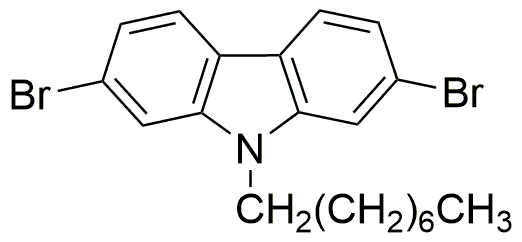2,7-Dibromo-9-n-octylcarbazole is widely utilized in research focused on:
- Organic Electronics: This compound is used in the development of organic light-emitting diodes (OLEDs), enhancing the efficiency and color purity of displays in smartphones and televisions.
- Photovoltaic Cells: It plays a crucial role in organic solar cells, improving energy conversion efficiency and stability, making renewable energy solutions more viable.
- Fluorescent Dyes: The compound is employed in creating fluorescent markers for biological imaging, aiding researchers in visualizing cellular processes with high precision.
- Polymer Chemistry: It serves as a building block in synthesizing advanced polymers, which are used in coatings and adhesives that require enhanced thermal and chemical resistance.
- Research in Material Science: This chemical is explored for its potential in developing new materials with unique electronic properties, contributing to innovations in various high-tech applications.
General Information
Properties
Safety and Regulations
Applications
2,7-Dibromo-9-n-octylcarbazole is widely utilized in research focused on:
- Organic Electronics: This compound is used in the development of organic light-emitting diodes (OLEDs), enhancing the efficiency and color purity of displays in smartphones and televisions.
- Photovoltaic Cells: It plays a crucial role in organic solar cells, improving energy conversion efficiency and stability, making renewable energy solutions more viable.
- Fluorescent Dyes: The compound is employed in creating fluorescent markers for biological imaging, aiding researchers in visualizing cellular processes with high precision.
- Polymer Chemistry: It serves as a building block in synthesizing advanced polymers, which are used in coatings and adhesives that require enhanced thermal and chemical resistance.
- Research in Material Science: This chemical is explored for its potential in developing new materials with unique electronic properties, contributing to innovations in various high-tech applications.
Documents
Safety Data Sheets (SDS)
The SDS provides comprehensive safety information on handling, storage, and disposal of the product.
Product Specification (PS)
The PS provides a comprehensive breakdown of the product’s properties, including chemical composition, physical state, purity, and storage requirements. It also details acceptable quality ranges and the product's intended applications.
Certificates of Analysis (COA)
Search for Certificates of Analysis (COA) by entering the products Lot Number. Lot and Batch Numbers can be found on a product’s label following the words ‘Lot’ or ‘Batch’.
*Catalog Number
*Lot Number
Certificates Of Origin (COO)
This COO confirms the country where the product was manufactured, and also details the materials and components used in it and whether it is derived from natural, synthetic, or other specific sources. This certificate may be required for customs, trade, and regulatory compliance.
*Catalog Number
*Lot Number
Safety Data Sheets (SDS)
The SDS provides comprehensive safety information on handling, storage, and disposal of the product.
DownloadProduct Specification (PS)
The PS provides a comprehensive breakdown of the product’s properties, including chemical composition, physical state, purity, and storage requirements. It also details acceptable quality ranges and the product's intended applications.
DownloadCertificates of Analysis (COA)
Search for Certificates of Analysis (COA) by entering the products Lot Number. Lot and Batch Numbers can be found on a product’s label following the words ‘Lot’ or ‘Batch’.
*Catalog Number
*Lot Number
Certificates Of Origin (COO)
This COO confirms the country where the product was manufactured, and also details the materials and components used in it and whether it is derived from natural, synthetic, or other specific sources. This certificate may be required for customs, trade, and regulatory compliance.


